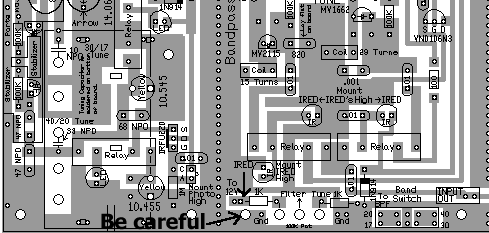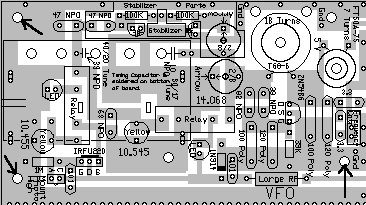

Bottom PlateThe following text describes how to put the receiver together as shown on the Home Page. If you have a problem when testing the boards, go to "LED Diagnosis/Troubleshooting" for help. ____Use a piece of PCB, aluminum plate, or steel plate to use as the bottom piece of the receiver. Dimensions are 8 1/2" by 8 1/2", the same size as the boards. (A drilled PCB plate will be included with the kit as supplies last.) |
|
Instructions if drilled bottom plate is not included with the kit. ____Using Board 1 layout as a template, drill holes through the bottom plate at the four corners. (Holes have already been drilled in the PCB material with most kits.)____Drill two holes across the front and back of the board, one on either side of the row of holes. ____Drill the holes in the VFO area. Two holes are located on either side of the text "VFO". One is located below the text "FT50A-75, 7 Turns", to the left of the VFO RF choke. The last one is above the text "120 Poly" a little ways to the right of the 3.3 pf capacitor. |
Mounting Board 1____A space of 1 3/4" is needed between the bottom plate and Board 1. This leaves enough room for the tuning capacitor, AADE Frequency Counter (mounted at a slight angle), the Frequency Stabilizer, and a power supply (if desired). If the spacers come pre-assembled, the longer ones are used between the bottom plate and Board 1. ____Connectors for +12 Volts, antenna, and speaker can be mounted on the back of the bottom plate. These connectors are not supplied with the kit. The prototypes used RCA connectors that soldered to the board.____Spacers (that use 6-32 hardware) are supplied with the kit. Two male/female spacers 1 1/4" long are attached and mounted with the male end on the bottom plate and attached with 6-32 screws. ____The minimum mounting holes is 6, one on each corner, one at the VFO next to the "Frequency Cntr" box, and one at the front of the VFO next to the text "Mount Photo High". Picture of Bottom Plate || Completed Bottom Plate____Board 1 slips over the male end of the spacers mounted on the bottom board. Picture Picture Showing Front, Showing Right Front, Showing Left Front Note: There is one place on the front of Board 1 where a spacer can short 12 Volts to ground. |

|
The "Be Careful" arrow points to the spacer and the rectangle pad above the spacer (with another arrow) that are shorted when a spacer is placed in this hole. Some of the pad can be removed to undo the short. Note: There must be a very good connection between the spacers and the ground plane around the VFO. If the spacers do not have a good ground connection the VFO frequency will be very unstable. The frequency will do quick jumps, especially when the main tuning capacitor is adjusted.  Arrows show location of holes.
____Clean the ground plane areas around the holes surrounding the VFO. There are three holes: one at the corner, the next hole to the right underneath the Photodiode, and one next to the "Frequency Cntr" box at the output of the VFO. Best to use sandpaper or even lightly tin the areas with solder.
If there is any problem with VFO stability, the first thing to check are loose spacers around the VFO or bad ground connections to the spacers. The spacers are made of aluminum and they are notorious for working loose with variations of temperature. Aluminum has a very high coefficient of expansion and the spacers will work themselves loose in a short time. The best thing to use, after the receiver is finished, is Lock-tite that is made for aluminum. The second best thing is enamel hobby paint or anything similar. When the spacers become loose, the VFO frequency will be very unstable. Loose spacers around the VFO will cause incredible instability. When the spacers are retightened, the VFO will run OK. A maximum of 12 places can be used to mount Board 1. The other holes around the VFO would be the first place to add mounting holes, especially the one to the right of the VFO coil next to the "Gnd" connection. |
Testing Board 1First Mixer/Post-Mixer Amplifier || Setting the VFO frequencies See Making Loops for Connections on the Boards for making easy connections to the board for testing and completing the board. ____Connect +12 Volts to the +12 Volt and Ground connections near the output of the VFO. Picture ____Be careful with polarity reversal. The 10mfd tantalums may blow up and some traces may be burned going to the 7805 and First Mixer. Use diode protection if a mistake might be made in connecting the board to 12 Volts.____Use a 1 amp diode, 1N4001 or similar at the 12 volt main connection to prevent accidentally hooking up the receiver with reverse polarity. (This diode is not currently supplied with the kit.) Bandpass and Crystal Filters____Turn both switches to 40 meters (Bandpass 40/30 side, Crystal 40/20 side). Picture____Bandpass Section - The LED on the 40/30 side should be on. (Right side) ____Crystal Filter Section - The LED on the 40/20 side should be on. (Left side) ____Move the Bandpass switch to the 20/17 side. ____The LED at the 20/17 filter should turn on (left side). If one of the LEDs at the Bandpass Filters is barely on, shield any light (overhead shop light, etc.) that is hitting the Photodiodes. The dim LED should go out. ____Move the Crystal Filter switch to the 30/17 side. ____The LED at the 30/17 crystal filter should turn on. (right side). Picture Troubleshooting the Bandpass Filter || Crystal FilterBandpass Filter Tune Pot____Place a VOM in DC Volts position, and measure the voltage at the FILTER TUNE Bold circle, and check its range while running the Filter Tune pot from end to end - +.2 to +11.2 Volts.TroubleshootingFirst Mixer/Post-Mixer Amplifier____First Mixer: Both LEDs should be on and just slightly lower in intensity than the Post-Mixer Amplifier LEDs. Adjust the "Gain Adjust" pot at the first VFO Amplifier counter clockwise, and the mixer LEDs should turn off.____Readjust the "Gain Adjust" pot clockwise so that the Mixer LEDs are full on. ____VFO Post-Mixer Amplifiers: The LEDs of the two Post-Mixer Amplifiers should be on. Troubleshooting |

Setting the VFO frequencies.____Connect a Frequency Counter to the output of the VFO labeled VFO OUT. There should be plenty of drive for any frequency counter. Note: See "VFO Troublshooting" if you don't have enough drive for the Frequency Counter. 31 and 16 Meter Bands
____Set the 2/8 ceramic trim pot (labeled 14.068) to its middle position. Line up the slot in the adjustment screw with the capacitor pins, with the rotor plate on the end with the arrow. The rotor plate is the part of the top with the metallic color. Note: All tuning to make the frequency reach 13.500 MHz is done by modifying the turns on the toroid. If the frequency will not reach 13.500 MHz, remove one turn on the toroid. If the frequency is too high, add a turn to the toroid. (This may require rewinding the toroid for a clean appearance, but having the frequency read too high is not a common error.) 19 Meter BandTurn on the VFO SPST switch that turns on the 10.545 MHz LED and relay. If you connected the switches as suggested in the instructions, it will be the one on the left. One LED will be on in the VFO Section. ____Set the VFO frequency by adjusting the yellow trim cap next to the 10.545 relay to 11.453 MHz. 41 Meter BandTurn on the VFO SPST switch that turns on the 10.455 MHz LED and relay. If you connected the switches as suggested in the instructions, it will be the one on the right. Both LEDs will be on in the VFO Section. Note: The 10.545 LED must be on for the 10.455 LED to turn on. Each relay adds more capacitance to the VFO as they are turned on lowering the VFO frequency. ____Set the VFO frequency by adjusting the yellow trim cap next to the 10.455 relay to 10.847 MHz. This will receive the 41 Meter band between 7.300 to 7.400 MHz. The 41 meter SWL band goes from 7.1 to 7.4 MHz, but the 7.1 to 7.3 segment is the SSB part of the 40 meter amateur radio band and is not covered. If coverage of the low end of the 41 meter band is desired, solder a 20pf NPO capacitor across the 10.455 yellow trim capacitor (underneath the board), and adjust the VFO to 10.647, which will tune the 41 meter band starting at 7.100 MHz. Back to Board 1, Section 1 - VFO and Amplifiers - Adding the 20pf CapacitorSecure the VFO____Secure the VFO toroid by whatever means you have decided. Some options are a small plastic wrap, a 4-40 screw/nut and 3/16" rubber grommet. Picture If you have already built Board 2, then go to Mounting/Testing Board 2. |
Send E-Mail || Amateur Radio Receivers || Electroluminescent Receiver || Back to Instructions for the Kit || Back to SWL Instructions
